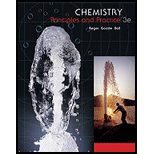
Concept explainers
(a)
Interpretation:
The fraction of acid ionized in
Concept Introduction:
A weak acid in water produces a hydrogen ion and conjugate base. When weak acid dissolves in water, some acid molecules transfer proton to water.
In solution of weak acid, the actual concentration of the acid molecules becomes less because partial dissociation of acid has occurred and lost protons to form hydrogen ions.
The reaction is as follows:
The reaction is as follows:
The expression for
For value of
The fraction ionized is equal to the ratio of concentration of ionized acid to analytical concentration multiplied by 100.
(a)
Answer to Problem 15.65QE
The fraction of acid ionized in
Explanation of Solution
The chemical equation for ionization of
The concentration of
Also,
Let us assume the concentration of
The ICE table for the above reaction is as follows:
The expression for
Substitute
Rearrange above equation to obtain the required quadratic equation to compute the concentration of hydrogen ion as follows:
Solve for x, therefore the concentration of hydrogen ion is as calculated follows:
Or,
Neglect, the negative value of x as concentration cannot be negative.
Therefore concentration of
The equation for fraction of acid ionized in
Substitute
Hence, the fraction of acid ionized in
(b)
Interpretation:
The fraction of acid ionized in
Concept Introduction:
Refer to part (a).
(b)
Answer to Problem 15.65QE
The fraction of acid ionized in
Explanation of Solution
The chemical equation for ionization of
The concentration of
Also,
Let us assume the concentration of
The ICE table for the above reaction is as follows:
The expression for
Substitute
Rearrange above equation to obtain the required quadratic equation to compute the concentration of hydrogen ion as follows:
Solve for x, therefore the concentration of hydrogen ion is as calculated follows:
Or,
Neglect, the negative value of x as concentration cannot be negative.
Therefore concentration of
The equation for fraction of acid ionized in
Substitute
Hence, the fraction of acid ionized in
(c)
Interpretation:
The fraction of acid ionized in
Concept Introduction:
Refer to part (a).
(c)
Answer to Problem 15.65QE
The fraction of acid ionized in
Explanation of Solution
The chemical equation for ionization of
The concentration of
Also,
Let us assume the concentration of
The ICE table for the above reaction is as follows:
The expression for
Substitute
Rearrange above equation to obtain the required quadratic equation to compute the concentration of hydrogen ion as follows:
Solve for x, therefore the concentration of hydrogen ion is as calculated follows:
Therefore concentration of
The equation for fraction of acid ionized in
Substitute
Hence, the fraction of acid ionized in
(d)
Interpretation:
The fraction of acid ionized in
Concept Introduction:
Refer to part (a).
(d)
Answer to Problem 15.65QE
The fraction of acid ionizedin
Explanation of Solution
The chemical equation for ionization of
The concentration of
Also,
Consider the concentration of
The ICE table for the above reaction is as follows:
The expression for
Substitute
Rearrangeabove equation to obtain the required quadratic equation to compute the concentration of hydrogen ion as follows:
Solve for x, therefore the concentration of hydrogen ion is as calculated follows:
Or,
Neglect, the negative value of x as concentration cannot be negative.
Therefore concentration of
The equation for fraction of acid ionized in
Substitute
Hence, the fraction of acid ionized in
Want to see more full solutions like this?
Chapter 15 Solutions
Chemistry
- The ideal pH of a swimming pool is 7.2. You measure the pH of your pool to be 6.5. What should you add, acid or base, to restore your pool to the ideal pH? acid base neitherarrow_forwardWrite a formula for the conjugate base formed when each of the following behaves as a Brnsted acid: a. HSO4 b. CH3NH3+ c. HClO4 d. NH4+ e. HClarrow_forwardWrite equations that show NH3 as both a conjugate acid and a conjugate base.arrow_forward
 Chemistry: Principles and PracticeChemistryISBN:9780534420123Author:Daniel L. Reger, Scott R. Goode, David W. Ball, Edward MercerPublisher:Cengage Learning
Chemistry: Principles and PracticeChemistryISBN:9780534420123Author:Daniel L. Reger, Scott R. Goode, David W. Ball, Edward MercerPublisher:Cengage Learning Chemistry by OpenStax (2015-05-04)ChemistryISBN:9781938168390Author:Klaus Theopold, Richard H Langley, Paul Flowers, William R. Robinson, Mark BlaserPublisher:OpenStax
Chemistry by OpenStax (2015-05-04)ChemistryISBN:9781938168390Author:Klaus Theopold, Richard H Langley, Paul Flowers, William R. Robinson, Mark BlaserPublisher:OpenStax Chemistry: Principles and ReactionsChemistryISBN:9781305079373Author:William L. Masterton, Cecile N. HurleyPublisher:Cengage LearningChemistry: Matter and ChangeChemistryISBN:9780078746376Author:Dinah Zike, Laurel Dingrando, Nicholas Hainen, Cheryl WistromPublisher:Glencoe/McGraw-Hill School Pub Co
Chemistry: Principles and ReactionsChemistryISBN:9781305079373Author:William L. Masterton, Cecile N. HurleyPublisher:Cengage LearningChemistry: Matter and ChangeChemistryISBN:9780078746376Author:Dinah Zike, Laurel Dingrando, Nicholas Hainen, Cheryl WistromPublisher:Glencoe/McGraw-Hill School Pub Co Chemistry for Today: General, Organic, and Bioche...ChemistryISBN:9781305960060Author:Spencer L. Seager, Michael R. Slabaugh, Maren S. HansenPublisher:Cengage Learning
Chemistry for Today: General, Organic, and Bioche...ChemistryISBN:9781305960060Author:Spencer L. Seager, Michael R. Slabaugh, Maren S. HansenPublisher:Cengage Learning





